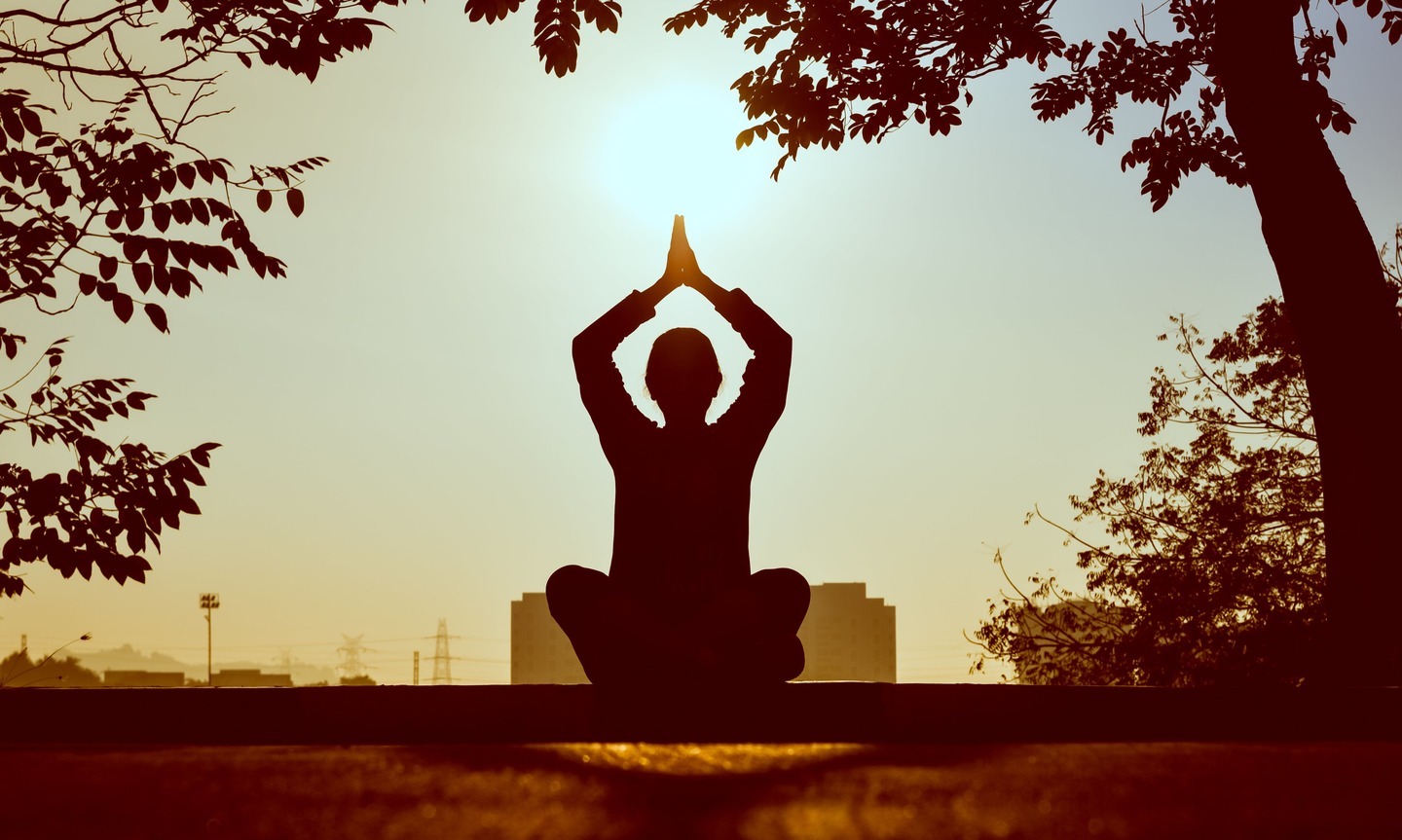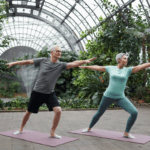Coming Soon: E-book about Kundalini Yoga - Sign up here to be among the first to get it!
Feeling anxious? You’re not alone. Many turn to yoga for anxiety, seeking calm and balance in a hectic world. Yoga transcends mere physical flexibility, serving as a profound mechanism for enhancing psychological well-being. In this exploration, we unveil the mechanisms by which yoga addresses anxiety’s core issues, offering tranquility to the mind and body by nurturing a state of awareness and calming our internal wiring.
Exploring further, you’ll uncover how certain positions such as the nurturing child’s pose and the stabilizing triangle pose play a crucial role in dissolving tension. Additionally, we’ll explore how certain breathing exercises can amplify the calming effects. Whether you’re new to yoga or looking to deepen your practice with an eye towards managing anxiety, there’s something here for everyone aiming to find peace within themselves.
Table Of Contents:
- Understanding the Nervous System’s Role in Anxiety
- Stimulating the Vagus Nerve with Yoga
- Effective Yoga Poses for Anxiety Relief
- Breathing Techniques That Enhance Anxiety Management
- Integrating Meditation into Your Yoga Practice for Anxiety Relief
- The Role of Hatha Yoga in Reducing Acute Stressors
- The Impact of Yoga on Physical Health Markers Related to Anxiety
- Getting Started with Yoga Therapy for Chronic Anxiety
- FAQs in Relation to Yoga for Anxiety
- Conclusion
Understanding the Nervous System’s Role in Anxiety
Anxiety transcends mere emotion, embedding itself within the intricate web of our nervous system’s architecture. At the heart of chronic anxiety lies an overactive sympathetic nervous system, which is essentially our body’s way of responding to stress. This “fight or flight” mode can get stuck in the ‘on’ position during prolonged periods of anxiety.
By engaging in yoga, we tap into a distinctive approach that calms our body’s stress response through various postures and breathwork, fostering serenity. Research has shown how practicing yoga regularly helps manage not only symptoms but also the physiological triggers behind them.
Stimulating the Vagus Nerve with Yoga
Yoga’s engagement with the vagus nerve is crucial for modulating our stress responses. It acts as a counterbalance to the sympathetic nervous system, calming down our bodies after they’ve been put on alert. Stimulating this nerve increases what scientists call ‘vagal tone,’ improving one’s ability to relax after stress.
Studies highlight how yoga stimulates this crucial nerve, enhancing interoception – awareness of internal bodily sensations – and thus allowing individuals with chronic anxiety to better regulate their emotions and reactions to stressful situations.
The intertwining of mental, physical, and respiratory elements through yoga offers a holistic adjunct to conventional therapy in mitigating symptoms of anxiety-related conditions such as GAD and episodes of panic.
Effective Yoga Poses for Anxiety Relief
Triangle Pose
Triangle pose, or Trikonasana, is not just a standing pose that challenges your balance but also an effective method to relieve anxiety. When you stretch into the triangle pose, it opens up your chest and shoulders. Engaging in this movement eases the strain frequently harbored within these regions, a common result of enduring stress. Additionally, studies have shown that engaging in yoga positions such as the Triangle can markedly lessen sensations of anxiety and stress.
This pose encourages deep breathing which is vital for calming the mind and reducing the sympathetic nervous system’s activity – responsible for our body’s stress response. Incorporating Triangle pose into your routine could serve as a pathway to mitigating long-term anxiety, nurturing both bodily vigor and serenity of the mind.
Bound Angle Pose
The Bound Angle Pose, known as Baddha Konasana in Sanskrit, acts as a grounding force that promotes relaxation by releasing hip tension. Sitting with your feet together and knees wide apart creates an angle beneficial for opening up the lower back and hips where we tend to hold emotional stress.
This relaxing posture encourages one to focus inwardly; thus enhancing mindfulness which has been linked with reduced symptoms of generalized anxiety disorder (GAD) according to studies on hatha yoga’s impact on acute psychological stressors. By including this simple yet powerful position in your routine, you’re giving yourself permission to let go of daily stresses gently.
Fish Pose
Fish Pose or Matsyasana offers more than meets the eye when it comes to battling against anxious thoughts and feelings and lowering blood pressure, crucial aspects affecting those experiencing severe forms of panic disorders or GAD. The heart-opening aspect of Fish allows deeper breaths—vitalizing lungs capacity while stimulating the vagus nerve known for its role in decreasing our fight-or-flight response.
Yoga’s not just good for the body, but it’s a game-changer for anxiety too. Poses like Triangle open your chest and cut stress, while Bound Angle Pose gets you grounded and Fish Pose helps slow down those racing thoughts. Breathe deep and let these poses guide you to calm.
Breathing Techniques That Enhance Anxiety Management
Extended Puppy Pose with Focused Breathing
When you combine the Extended Puppy Pose with specific breathing practices, it becomes a powerful tool for relaxation. Engaging in this stance elongates your backbone and shoulder areas, ushering in a wave of bodily relief that sets the stage for serene tranquility to unfold.
Focusing on your breath while in this position amplifies its benefits. Long exhale or diaphragmatic breathing during the pose stimulates the vagus nerve. This is crucial because stimulating this nerve aids in shifting from a state of stress to one of relaxation by activating our body’s parasympathetic nervous system—the part responsible for rest and digest functions.
To get more insight into how pranayama can deepen your connection between mind and body leading to enhanced calming effects, explore these pranayama benefits. Merging the practice of specific poses with intentional breathing not only elevates relaxation methods but also bolsters our general health by adeptly regulating stress.
Anxiety management through yoga doesn’t just stop at poses; it extends into how we breathe during those poses. By practicing controlled breathing techniques like long exhales within an extended puppy pose, individuals have found significant relief from anxiety symptoms. Such practices directly engage with our physiological responses to stress, offering a natural pathway towards tranquility without relying solely on medication or external interventions.
This approach aligns perfectly with current research highlighting how chronic anxiety links back to an overactive sympathetic nervous system—a problem pranayama addresses directly by enhancing interoception (our internal sensing abilities) and increasing vagal tone which are both key factors in reducing feelings of anxiety.
Integrating Meditation into Your Yoga Practice for Anxiety Relief
Meditation, when combined with yoga, offers a powerful duo for managing anxiety. By melding this method into your routine, you not only heighten awareness of your physical self but also unlock a profound capacity for mental and corporeal relaxation.
Research indicates that meditation fosters self-control, heightened awareness, and calmness—essential instruments for battling anxiety. Merging meditation with your yoga routine not only eases stress but also nurtures a tranquil haven within, resilient against the tempests of daily life.
Integrating meditation with yoga can profoundly change the lives of those grappling with anxiety, serving as a beacon of transformation. A study comparing a yoga group to a control group revealed how participants practicing yoga reported significantly lower levels of stress and anxiety compared to their counterparts. This highlights how blending these techniques into a comprehensive strategy for mental well-being can be incredibly potent.
The Science Behind Yoga Increases Body Awareness
Becoming more attuned to one’s physical state through yoga poses encourages mindfulness—a critical component in recognizing early signs of anxiety and addressing them proactively. By fostering greater bodily awareness, individuals are better equipped to notice tension build-up or shifts in breathing patterns indicative of rising stress levels.
This heightened sensitivity allows practitioners to apply relaxation techniques more effectively before feelings escalate into full-blown panic attacks or severe anxious episodes.
Meditation Promotes Relaxation Beyond Traditional Methods
Including Qigong meditation within your routine introduces another layer of calming influence on the nervous system. Known for its gentle movements and focused breath work,Qigong has been linked to improvements in both psychological well-being and physical health markers such as blood pressure—a common physiological symptom associated with chronic stress and anxiety disorders.
This multifaceted approach leverages the best aspects each discipline has to offer—combining physical movement with meditative stillness—to forge a comprehensive path towards managing daily anxieties more effectively than either could alone.
Mix yoga with meditation to tackle anxiety head-on. This combo boosts body awareness and helps release tension, offering a solid strategy for creating peace within. Studies back up its power in reducing stress, making it a game-changer for mental health.
The Role of Hatha Yoga in Reducing Acute Stressors
Hatha yoga, a gentle form of yoga that focuses on static poses and is known for its stress-relieving properties, offers significant benefits to those grappling with acute psychological stress. A recent study highlighted how just one session can markedly reduce such stressors, showcasing hatha yoga’s effectiveness as an anxiety reduction tool.
Diving into particular hatha yoga sequences offers a robust strategy for navigating through stress-laden moments. The methodical breathing and slow movements help soothe the mind and body, making it an effective anxiety reduction technique. If you’re keen on adding this method to your daily habits, grasping the crucial elements that drive its effectiveness is pivotal.
Understanding the Nervous System’s Role in Anxiety
Anxiety often stems from an overactive sympathetic nervous system which triggers our ‘fight or flight’ response even when there’s no real threat present. This condition aggravates anxious sensations and impacts health indicators linked to anxiety maladies, such as elevated blood pressure.
Yoga serves as a bridge between physical movement and mental relief by stimulating the vagus nerve—known for controlling relaxation responses—and increasing interoception awareness (our internal sense of what’s happening in our bodies). These actions encourage a shift towards the parasympathetic nervous system or ‘rest and digest’ mode, thereby reducing symptoms associated with chronic anxiety.
Effective Yoga Poses for Anxiety Relief
Incorporating poses such as Triangle Pose helps open up chest areas where tension accumulates while promoting grounding through Bound Angle Pose which releases hip joint stiffness—an area commonly affected during anxious states. Fish Pose goes further by opening respiratory channels enhancing overall relaxation through improved breathing patterns.
Research supports these practices, indicating significant improvements in participants’ ability to manage acute psychological stress after engaging with them.
Hatha yoga shines as a stress-buster, turning down acute anxiety with just one session. It calms the mind and eases the body through slow poses and breaths, making it a go-to for instant relief. Key poses like Triangle Pose open up tense areas, while Fish Pose boosts relaxation by improving breathing.
The Impact of Yoga on Physical Health Markers Related to Anxiety
Viewed as a comprehensive healing art within alternative healthcare, yoga significantly contributes to the mitigation and possible relief of anxiety-related symptoms. Yoga isn’t just about striking poses; it’s a blend of breath control and meditation that together aim to uplift one’s mental wellbeing.
Understanding the Nervous System’s Role in Anxiety
Anxiety isn’t just about feeling stressed or worried. Anxiety originates from how our bodies react to what we think are dangers, causing the sympathetic nervous system to kick into overdrive. This hyperarousal can lead to high blood pressure among other symptoms linked with panic disorder and generalized anxiety disorder. Through yoga intervention, there is potential for bringing balance back by stimulating the parasympathetic nervous system – essentially telling your body it’s time to relax.
Research highlights the role of consistent yoga practice in markedly decreasing hypertension, signaling a diminished stress reaction among those grappling with persistent worry and fear.
Stimulating the Vagus Nerve with Yoga
In exploring ways through which yoga aids anxiety relief, we cannot overlook its impact on the vagus nerve – crucial for calming down our ‘fight or flight’ reactions. Engaging in specific poses like child’s pose or practicing deep breathing exercises directly stimulates this nerve, thus promoting relaxation and reducing feelings of anxiousness.
This approach not only aids in controlling present discomforts but also furnishes people with the strategies required for enduring robustness amidst challenges.
By incorporating practices such as these into one’s routine, people dealing with severe forms of anxiety have found solace and improvement in their overall quality of life without always having to rely solely on medication or conventional treatment options.
Yoga transforms from mere physical activity into a robust therapeutic approach, providing not only quick solace but also fortifying defenses against forthcoming bouts of anxiety.
Yoga does more than stretch your body; it’s a powerful therapy for anxiety, blending poses, breath work, and meditation to lower stress levels and enhance mental health. Regular practice can calm the ‘fight or flight’ response, offering immediate relief and building resilience against future stress.
Getting Started with Yoga Therapy for Chronic Anxiety
Embarking on yoga therapy could be a glimmer of light for anyone entangled in the enduring struggle against chronic anxiety. Yoga therapy, with its customizable routines, promises a personalized healing journey accessible from the sanctuary of your own living space. For individuals battling generalized anxiety disorder and similar conditions, it proves to be a remarkably effective remedy.
According to the 2024 State of Mental Health in America Report, a significant portion of the population is dealing with mental health challenges, making accessible treatment options like yoga more vital than ever. Originating from age-old practices, yoga has transformed into an acknowledged adjunct therapy renowned for its potent defense against intense anxiety.
Understanding the Nervous System’s Role in Anxiety
Anxiety often stems from an overactive sympathetic nervous system which puts our bodies on high alert even when there’s no real danger. Here lies one reason why practicing yoga can be transformative—it stimulates the vagus nerve responsible for calming down this fight or flight response.
This stimulation not only enhances interoception—our internal sense of body awareness—but also increases vagal tone, both crucial factors in managing and reducing symptoms related to chronic stress and anxiety disorders. Delving deeper into how chronic anxiety affects our stress response systems shows us just how potent stimulating the parasympathetic nervous system through targeted exercises like yoga can be.
The Impactful Blend: Yoga Poses and Breathing Techniques
Diving into specific poses such as Triangle Pose or Bound Angle Pose provides physical relief by opening up tight areas that store tension while encouraging grounding and relaxation—a double whammy against stressors triggering panic attacks or exacerbating generalized anxiety disorder symptoms.
Marrying these poses with pranayama (breathing techniques) amplifies their effectivity. Focused breathing within an Extended Puppy Pose draws attention inward promoting mindfulness—an essential skill for anyone looking to navigate stressful situations more calmly—and encourages physiological changes conducive to relaxation.
Yoga therapy shines as a hopeful path for those with chronic anxiety, offering customizable practices to ease the mind from home. It’s recognized for calming the fight or flight response and enhancing body awareness, proving its worth in managing stress and anxiety disorders through specific poses and breathing techniques.
FAQs in Relation to Yoga for Anxiety
Which yoga is best for anxiety?
Hatha and Vinyasa are top picks. They blend movement with breath, dialing down stress and lifting your mood.
What is the 3 3 3 rule for anxiety?
Name three things you see, and hear, then move three body parts. It’s a quick hack to ground yourself and cut through panic.
Does yoga actually help anxiety?
Absolutely. By focusing on breathing and posture, it lowers stress hormones, making you feel calmer and more in control.
How long does it take for yoga to help anxiety?
You might notice changes immediately but stick with it regularly for weeks or months to really harness those zen vibes.
Conclusion
Diving into yoga as a method to tackle anxiety can really turn the tables for you. Keep in mind, yoga transcends mere physical postures; it’s a journey towards serenity within.
Key takeaways? The nervous system plays a big role in anxiety. Poses like the triangle and bound angle are your friends here. And don’t forget breathing techniques—they’re crucial for deep relaxation.
Start small, but start now. Incorporate these habits into your daily life for enhanced stress control and to foster a healthier state of mind.
Leverage yoga as an alternative medicine that speaks directly to both mind and body. It’s more than exercise; it’s a pathway to peace.
In this journey toward tranquility, every pose counts, every breath matters—let them guide you away from chaos towards balance.
Sign up for our newsletter to stay updated with the latest articles, or ask me anything!




